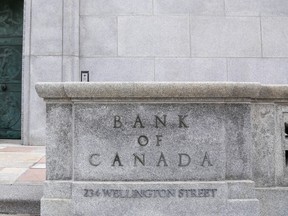Article content
The global financial system has thus far proven resilient to the stress of rising interest rates and other economic challenges, but risks are starting to creep in, the International Monetary Fund is warning. Speaking at a Bank of Canada event Nov. 7, IMF chief economist Pierre-Olivier Gourinchas said that a number of problem spots are looming on the horizon, from U.S.-dollar dependence to the siloing of global trade. The Financial Post’s Denise Paglinawan breaks down some of the key takeaways from Gourinchas’ speech.
Article content
The death of the U.S. dollar’s dominant position at the centre of trade has been greatly exaggerated through the years, with foreign demand for greenbacks growing unabated. That has created a system Gourinchas said is ultimately self-reinforcing — the more foreign firms and governments need the U.S. dollar to effectively execute transactions, the more they’ll have to manage their own currencies in order to obtain said dollars. Without that stability, longer-term planning becomes difficult, which creates overall economic uncertainty.
That U.S. dollar demand necessitates a backstop
Given that demand, Gourinchas said the IMF believes something of a “global financial safety net” is needed — basically a way to provide liquidity in U.S. dollars during times of stress, so individual economies don’t grind to a halt. Put simply, if a country can’t obtain the right currency to match its liabilities and creditors refuse an alternative payment, the country is stuck. As it stands, countries are mostly engaged in what Gourinchas said amounted to “self-insurance” — it’s up to them to keep the right currencies on the books.
Article content
Elevated interest rates make this dollar demand trickier
With those factors at play, Gourinchas said there’s a tricky balancing act in terms of how to meet U.S. dollar demand in this environment. While the U.S. government is generally able to borrow at the lowest possible rates available, as it’s seen as the least likely entity to default, it sells bonds in order to issue the U.S. dollars the world demands. While it often turns around and uses some of that cash to buy back previously-issued bonds for cancellation, the current interest rate and debt environment has never been seen before. Those distortions, set off by the pandemic, make this a tricky environment to navigate when it comes to such transactions.
Geopolitical fragmentation throws another wrench in the works
Then there are the rapidly evolving geopolitical pressures buffeting global trade, a key risk flagged by Gourinchas. He said that with countries such as China, with its Belt & Road initiative, moving toward a sphere-of-influence model over geographical proximity to cultivate trade partners, there’s a risk of a silo effect. The U.S. and its allies have responded, albeit on a less-pronounced level, by focusing on politically aligned countries for new trade connections. So-called “friendshoring,” however, ultimately raises the cost of doing business by diverting trade away from jurisdictions where certain goods can be produced more efficiently, but with greater geopolitical risk.
Related Stories
-
BoC worried government spending could impede inflation fight
-

Canadians’ view on economy, personal finances darkens
-

Get ready, the Fed has cause for a pause
• Email: dpaglinawan@postmedia.com
Bookmark our website and support our journalism: Don’t miss the business news you need to know — add financialpost.com to your bookmarks and sign up for our newsletters here.
Share this article in your social network
Risks are starting to creep into global financial system, IMF warns
2023-11-08 19:13:08







